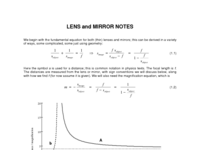Concave Mirror Images
This applet shows image formation via principal rays for a concave mirror. The circular (section of a spherical) mirror has a fixed radius of 3 units. Two dashed lines are radii of the circular mirror, which of course are normal to its surface.
Shown behind the circular mirror is a parabolic mirror, which has the property that all rays parallel to its axis, no matter how far from the axis they are, will be reflected through its focus, which is at the same location as the focus of the circular mirror (i.e., at R/2, here 1.5 units; see Hecht, Optics, 2nd Ed., p.158).
The height (h) and location (sobj) of the object are adjusted with sliders; select a slider and use the arrow keys for fine adjustments. The entire figure can be zoomed in/out with the mouse wheel; click/drag to move it left-right.
The applet is provided since it can be useful as-is, but it will be updated to include the virtual images that happen when the object is inside the focal point of the mirror (at 1.5 units). At present these are excluded by restricting the lower bound of the object distance.
Of particular interest is the discrepancy between the image size and location found with the usual formulas (see the attached PDF) and that indicated by the intersection of the reflected rays. The red image is based on these calculations, and it is clear that, if the object size is too large relative to the mirror radius, the calculated image does not match that of the intersections. This is an example of "spherical abberation."
As the object size decreases, so that the principal rays are closer to the axis ("paraxial" assumption), the image agreement improves. One way of thinking about this assumption is that this is a region of the circular mirror that best approximates the parabolic mirror.
To explore this, place the object at the circle center (3), and then vary the object height. Observe the intersection points; the height must be relatively short before these points converge. When this happens, note that the circular and parabolic mirror surfaces are very close together. (There are black dots on the parabola indicating the intersection point on it for two principal rays.)
For a given object height, the calculation/intersection agreement also improves as the object moves farther away from the mirror.
As an approximate way to assess the aberration, a value is calculated using Eq. 6.40, p.221 in Hecht, Optics, 2nd Ed. The last term of that equation is used here, and arbitrarily scaled by 100, so that indicated values of about 1 or less represent relatively small amounts of aberration. When this is the case, the calculated image and ray intersections are usually in reasonable agreement. The expression used here includes the circle radius, the height of the object, and the object distance; it also has two indices of refraction, which here are both set to unity.
